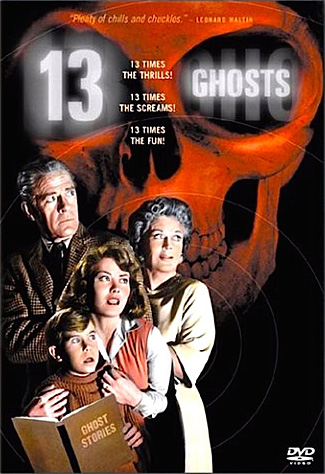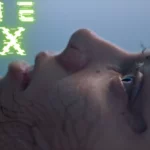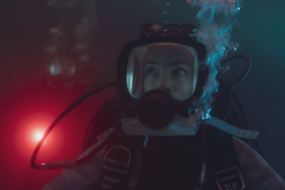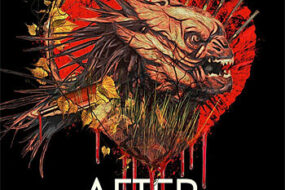
Not Rated | Black & White | 84 minutes
Directed by William Castle
Also Known As: 13 Fantasmas
Purchase it: Amazon.com (DVD) | Amazon.com (Blu-ray)
WARNING: THIS REVIEW CONTAINS SOME MINOR SPOILERS!
While I haven’t seen the bulk of William Castle’s directorial efforts, the few I’ve watched have left a lasting impression. From the skeletal shenanigans of HOUSE ON HAUNTED HILL (filmed in EMERGO!) to Vincent Price’s panicked ravings of “Scream! Scream for your lives!” at the climax of THE TINGLER (filmed in PERCEPTO!), I quickly became a fan of Castle’s gimmicky cinematic exploits. So, it’s no surprise that I had a blast revisiting his 1960 effort, 13 GHOSTS! (Filmed in ILLUSION-O!)
As the film begins, we meet the Zorbas, a down-on-their-luck family whose furniture is being repossessed because the absent-minded patriarch, Cyrus (Donald Woods), forgot to pay the bills. But fate steps in that evening as Cyrus, his wife Hilda (Rosemary DeCamp), daughter Medea (Jo Morrow), and plucky young son Buck (Charles Herbert) sit together on the floor in their empty home, celebrating Buck’s birthday.
Moments after Buck makes his birthday wish (for a house full of furniture) and blows out his candles, there’s a knock at the door with some mixed news: Cyrus’s eccentric uncle Dr. Plato Zorba has passed away and left his nephew a fully furnished mansion! The only downside? The house comes with a peculiar caretaker named Elaine Zacharides (Margaret Hamilton – yes, that Margaret Hamilton!) Oh, and it’s haunted by eleven spirits that Dr. Zorba collected from all over the world!
Understandably skeptical of their new home’s haunted status, the Zorbas move in immediately and discover they do indeed have some spectral tenants. But there’s also a mystery afoot! Plato Zorba was quite wealthy and had hidden his remaining fortune somewhere in the house before his untimely demise. Though the Zorbas are initially unaware of this, someone else knows about the hidden money and will resort to anything, even murder, to get their greedy paws on Plato’s dough! (Pla-dough?)
As the film progresses, we get a little casual Ouija board usage, the discovery of a secret lab, and the introduction of Zorba’s greatest scientific achievement: the “ghost viewers!” By wearing these large boxy goggles, the characters in the film can see the spirits, which include an angry chef who killed his wife and her lover, a lion and his headless tamer, and (gasp!) Plato Zorba himself, who somehow became Ghost #12!
Plato’s death was the result of foul play, and the culprit behind his murder is now trying to oust the Zorbas to more easily seek out the hidden money without attracting attention. Since there aren’t many other characters in the film, it’s easy to figure out who the villain is, but I won’t ruin the “shocking twist” for you. However, the film finally lives up to its title once the would-be thief gets their comeuppance during the climax!
13 GHOSTS was the fourth film William Castle self-financed after parting ways with Columbia Pictures, featuring the “Illusion-O” process, one of Castle’s better theatrical gimmicks. While the film was shot in black and white, the footage during the Illusion-O sequences was tinted blue, and the ghosts were tinted red. Audience members could use the cardboard and cellophane “ghost viewers” handed out at the door to peek through the blue cellophane to see the ghosts or through the red if they became “too frightened.”
While the Illusion-O concept seems silly, having experienced it both at home (on DVD) and on the big screen (in 35mm), I found it a fun way to make the film more interactive. Plus, the ghost viewers make a nifty souvenir! But does the film hold up on its own without Castle’s Illusion-O? Believe it or not, it does! Penned by Robb White (a Castle regular), the screenplay for 13 GHOSTS is competent but hackneyed: it feels like HOUSE ON HAUNTED HILL lite, with both films involving a haunted house, a whodunit subplot, and characters vying for a small fortune.
Despite using a similar formula, White makes enough changes to keep things interesting. Plus, 13 GHOSTS has a decent cast. Donald Woods (THE BEAST FROM 20,000 FATHOMS, DIMENSION 5) is good as the forgetful father pulled into a mystery by a relative from beyond the grave, and both Jo Morrow (big sis Medea, the film’s eye candy) and Rosemary DeCamp (Momma Zorba) do well with their roles.
Martin Milner is also good as Benjamin Rush, the friendly lawyer with a dark secret, but they are all eclipsed by Charles Herbert (THE COLOSSUS OF NEW YORK, THE FLY) as Buck Zorba. He proves to be a likable and precocious young protagonist, one of the better child actors I’ve seen in any film. Margaret Hamilton is also present but more of a distraction, constantly reminding us of her role as the Wicked Witch of the West from THE WIZARD OF OZ.
Oddly enough, it’s the titular spirits that are the film’s biggest shortcoming. These superimposed specters, brought to life using people in costumes, a real lion (the gentle and loveable Zamba), and various props, fail to propel the story forward or elicit genuine chills. In fact, I’m certain no one would notice if most of the ghost/Illusion-O footage was edited out.
Still, 13 GHOSTS was a financial success in 1960, earned a remake in 2001, and cemented itself as a minor classic in William Castle’s diverse filmography. With its unique gimmick, likable characters, hint of intrigue, and smart (albeit formulaic) script, the film doesn’t fail to entertain. 13 GHOSTS is rarely scary but often amusing, and I feel comfortable giving it a rating of 3






